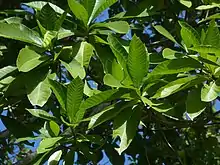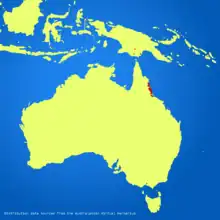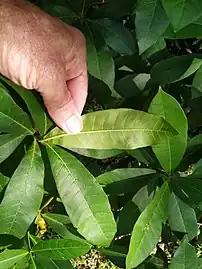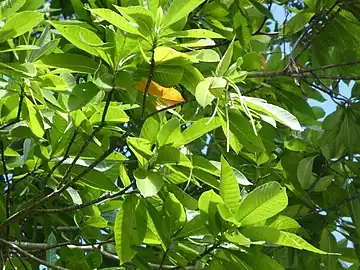Alstonia muelleriana
Alstonia muelleriana is a tree in the dogbane family Apocynaceae which is native to southern Papua New Guinea and northeastern Queensland.
| Hard milkwood | |
|---|---|
 | |
| Foliage | |
| Scientific classification | |
| Kingdom: | Plantae |
| Clade: | Tracheophytes |
| Clade: | Angiosperms |
| Clade: | Eudicots |
| Clade: | Asterids |
| Order: | Gentianales |
| Family: | Apocynaceae |
| Genus: | Alstonia |
| Species: | A. muelleriana |
| Binomial name | |
| Alstonia muelleriana | |
 | |
| Synonyms[4] | |
| |
Description
Alstonia muelleriana is an evergreen tree growing to between 15 and 25 m (49 and 82 ft) in height.[5][6] The leaves are simple and produced in whorls of three or four. They measure up to 19 by 7 cm (7.5 by 2.8 in) and are attached to the twigs by a petiole about 8 mm (0.31 in) long.[5][6][7] They are softly hairy on both sides (less so on the top) and have up to 18 lateral veins either side of the midrib.[5][6][7]
The inflorescences are terminal or axillary panicles up to 10 cm (3.9 in) long.[6] The small flowers are about 5 mm (0.20 in) diameter and are 5-merous, with five green sepals and five white/cream petals.[5][6][7]
The fruit is a green dehiscent follicle, measuring around 40 cm (16 in) or more in length and 6–9 mm (0.24–0.35 in) diameter. At maturity they turn brown and split longitudinally, releasing numerous small, hairy seeds that are dispersed by the wind.[5][6][7]
Taxonomy
This species was first described in 1928 by the Czech botanist Karel Domin, who published his description in the book Bibliotheca Botanica.[3][4]
Etymology
The genus name Alstonia was raised by the Scottish botanist Robert Brown in 1811, in honour of his countryman Charles Alston. The species epithet muelleriana is in honour of the German-born Australian botanist Ferdinand von Mueller.[6]
Distribution and habitat
The range of the hard milkwood is restricted to a small part of northeastern Queensland, from near Rossville to the Paluma Range N.P. north of Townsville, and also the southwestern parts of Papua New Guinea.[8]
It grows in rainforests, but is also found in drier forests and is common in regrowth or disturbed areas.[5][7]
Conservation
This species is listed by both the Queensland Department of Environment and Science and the IUCN as least concern.[1][2] The IUCN states in its assessment that the population is stable and that no current or future threats have been identified.[2]
Gallery
 Small tree
Small tree Foliage
Foliage Foliage
Foliage Foliage and unripe fruit
Foliage and unripe fruit
References
- "Species profile—Alstonia muelleriana". Queensland Department of Environment and Science. Queensland Government. 2022. Retrieved 10 January 2023.
- IUCN SSC Global Tree Specialist Group & Botanic Gardens Conservation International (BGCI). (2021). "Alstonia muelleriana". IUCN Red List of Threatened Species. 2021: e.T192228195A192228197. doi:10.2305/IUCN.UK.2021-1.RLTS.T192228195A192228197.en. Retrieved 10 January 2023.
- "Alstonia muelleriana". Australian Plant Name Index (APNI). Centre for Plant Biodiversity Research, Australian Government. Retrieved 10 January 2023.
- "Alstonia muelleriana Domin". Plants of the World Online. Royal Botanic Gardens, Kew. Retrieved 10 January 2023.
- Forster, P.I. (2020). "Alstonia muelleriana". Flora of Australia. Australian Biological Resources Study, Department of Agriculture, Water and the Environment: Canberra. Retrieved 10 January 2023.
- Cooper, Wendy; Cooper, William T. (June 2004). Fruits of the Australian Tropical Rainforest. Clifton Hill, Victoria, Australia: Nokomis Editions. p. 32. ISBN 9780958174213.
- F.A.Zich; B.P.M.Hyland; T.Whiffen; R.A.Kerrigan (2020). "Alstonia muelleriana". Australian Tropical Rainforest Plants Edition 8 (RFK8). Centre for Australian National Biodiversity Research (CANBR), Australian Government. Retrieved 10 January 2023.
- "Search: species: Alstonia muelleriana | Occurrence records | The Australasian Virtual Herbarium". Australasian Virtual Herbarium. Australian Government. Retrieved 13 January 2023.
External links
 Data related to Alstonia muelleriana at Wikispecies
Data related to Alstonia muelleriana at Wikispecies Media related to Alstonia muelleriana at Wikimedia Commons
Media related to Alstonia muelleriana at Wikimedia Commons- View a map of historical sightings of this species at the Australasian Virtual Herbarium
- View observations of this species on iNaturalist
- View images of this species on Flickriver
